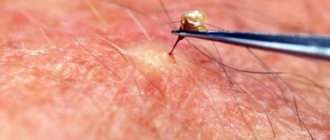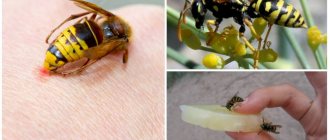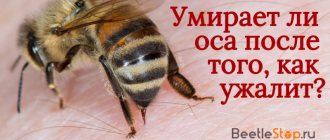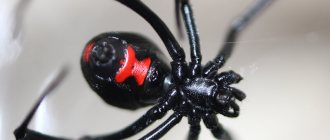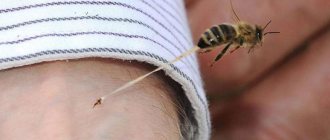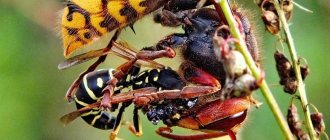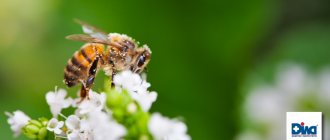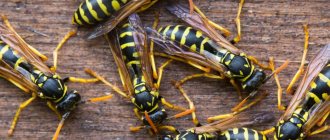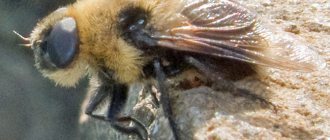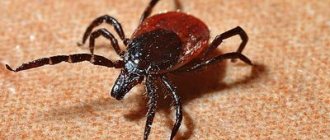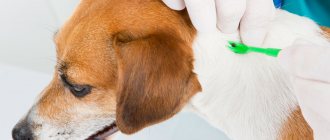Only female wasps have a sting. It serves as a weapon of defense and attack. With its help, the wasp paralyzes the victim and takes it to the nest to feed its growing offspring.
To some people, the question of whether a wasp has a sting may seem obvious. However, this is not entirely true.
In fact, every female wasp has a sting, but males cannot boast of such a unique weapon. People's confidence in the presence of a sting in all wasps is due to the fact that most wasps belonging to the common paper species are females. That is why almost all wasps have a sting in their arsenal, which can be found on a plot, on an apartment balcony, in a house, or just on the street.
The presence of a sting on a wasp
It just so happened that in the process of evolution, the wasp ovipositor in females was somewhat reshaped, became much harder and connected to the poison gland. This is how the sting appeared, and as is now clear, it appeared only in females. Males cannot anatomically possess such an organ due to the lack of an ovipositor. But since in wasp families females predominate quantitatively (there are few males, and they become active only during certain periods), this is where the opinion was formed that wasps have a sting in principle.
A wasp's sting, unlike a bee's, does not have serrations, which gives wasps the opportunity to sting several times without injuring themselves when stung.
The wasp's sting is its main defense and “tool” for obtaining food. Since wasps are hunters and predators by nature, they kill their victims (beetles, spiders, etc.), but not always with a sting. The jaws of wasps are not equipped with teeth, but they are so strong that they can even bite through the hard chitinous covering of some insects. In this way, wasps sometimes “save” poison. The wasp needs the sting in order to poison and paralyze the victim, injecting a portion of poison into its body after the puncture. The composition of this poison may differ in its composition among different species of wasps, while the structure of the sting is approximately the same in all of them.
Does the wasp die?
The bee stings and dies, because during the detachment of the sting, the gland with poison and the digestive tract are damaged, which leads to death.
The wasp stings a person and, with the help of its muscles, pulls him back and flies away, even if it so happens that she loses her weapon, this will not affect her life in any way, the only thing is that she can only defend herself with the help of her jaws.
Wasps have an amazing feature, due to the fact that they have thin waists, they are able to fold in half and deliver devastating blows. A huge number of species, from large to small representatives, have their own poison and can harm human health from a few seconds to one minute.
Please note that hot weather fuels their aggressive reaction. This is such a dangerous and insidious species of insects, but let’s make a reservation that they will never attack without a reason.
Anatomy of the sting and stinging mechanism
Externally, the sting of a wasp resembles a long thin needle. This is a very durable organ with a channel-duct inside, connected to a poisonous gland. Thanks to this connection, the poison enters the victim’s body through the duct.
Wasp sting under a microscope
In a calm state, the sting is “retracted” to the back of the wasp’s body and hidden there by special plates. In a state of aggression, before a bite, the plates open and the sting “moves out” from the inside along the so-called sled. In fact, the sting is two closed “stilettos”, its walls are smooth, and to the naked eye they appear dark, almost black, but in fact they are translucent. Through the channel-duct between the stylets and the sled, the poison is released into the body of the victim. The stilettos themselves do not have a channel, therefore, if the sting (stilettos) does not penetrate deep enough into the body, the poison may not get there.
Immediately after the bite, having quickly injected the poison, the wasp does not always remove the sting back inside: this allows it to sting several times in a row (on average up to 4-5 times). The wasp is capable of piercing the victim with its sting, provided that the body cover is softer than the sting; otherwise, instead of the sting, the wasp will have to use its powerful jaws.
A wasp only has one sting for its entire life. Even if she loses him, it’s not so scary for her. Loss of a sting is generally not typical for these insects (unlike bees). This is only possible if you slam the wasp at the exact moment of the bite.
The structure of a wasp sting
If you take a magnifying glass, the structure of the sting can be studied in more detail, although the naked eye can see that a sharp needle sticks out of the wasp’s body. Below in the photo you can see what a wasp sting looks like.
The appearance resembles a rather sharp element, inside of which there is a channel that is connected to the gland that produces poison. After a bite, the sting expands and a portion of the poison enters the wound. In its normal state, the sting is practically invisible, since it is retracted into the abdomen and covered with protective plates. In case of aggression, the needle extends and performs its protective functions.
The surface of the wasp's sting is smooth, without serrations, so it easily penetrates the body of its victim and is just as easily removed from it.
Important point! The sting is transparent, although visually it is dark, almost black.
Differences from a bee sting
As already mentioned, the wasp sting is smooth. In contrast, the bee’s sting is “equipped” with notches along its entire length, thanks to which the bee cannot pull out its “weapon” back after being stung. Therefore, if she manages to fly away, it is only by tearing off the back part of the body along with the sting, which remains in the body of the victim. After this, the severed part of the abdomen continues to pulsate, “pumping” more and more poison into the stung area (that’s why it needs to be removed as quickly as possible).
Of course, after a bite, leaving part of the internal organs along with part of the abdomen on the victim, the bee soon dies. In contrast, the wasp sting is absolutely smooth, can be freely and instantly pulled back out of the skin in the absence of any jagged edges. As already mentioned, a wasp can leave a sting in a victim only if it is swatted at the scene of the crime.
Which is correct: does the wasp bite or sting?
The wasp is armed not only with a sharp sting, but also with rather sharp jaws, with which it can easily bite the chitinous layer of some insects. Therefore, when hunting insects, it does not always use its sting. Thus he saves the poison.
When a wasp bites a person, it will definitely use its sting, releasing a certain amount of poison into the wound. At the same time, having stung once, it will try to do it again, since the sting does not remain in the victim’s body.
Therefore, a wasp can sting several times, and the number depends on the type of wasp, its age, and the amount of venom the wasp's body can produce. As a rule, each wasp is capable of stinging at least 5 times, which can lead to a number of negative consequences. Below you can see a wasp sting piercing a human body.
Interesting to know! Wasps are quite aggressive insects, but most aggression is possible if the wasp senses danger or if someone is trying to destroy its nest. If someone tries to get rid of a wasp nest without protective equipment, they will receive many stings from the entire family. In case of danger, they give signals, after which a whole swarm can appear next to the enemy.
How to remove a sting
Removing stings from skin is more about bee stings than wasp stings. However, if it so happens that the wasp sting remains inside, it must be removed in the same way as a bee sting:
- It’s best to take tweezers and disinfect them;
- you need to pull out the sting very carefully so that it comes out entirely (when stung by a bee, pull on the remaining part of the abdomen);
- to alleviate the condition after removing the sting, use traditional or folk methods (applying cold is good as first aid);
- treat the wound so that it does not get infected (you can use iodine);
- In case of complications, consult a doctor immediately.
When an insect leaves a sting when biting
Only the bee leaves a sting when biting, since only it is all serrated. It clings to the skin and remains in the wound along with the poisonous reservoir. This reservoir has autonomous muscles, which, even when separated from the body, contract for another 20 minutes, injecting the remaining poison under the skin. There is logic in this: even if the bee is brushed away or crushed, the poison will still enter the enemy’s body. Actually, a bee always dies after stinging. But the loss of one soldier in an army of ten thousand is not terrible, but the enemies of the hive can be large (remember bears), and they must be neutralized quickly and reliably.
Interesting Facts
Any type of wasp has a sting, its own terrible weapon. The difference is that the strength of the poison’s effect on the victim’s body may vary depending on the concentration, which is different for each species. And the intensity of pain after a bite is also different for the same reason.
For example, the hornet is the largest wasp, it stings very painfully, and the poison injected into the victim can be fatal even to a person, and even just one bite can kill an allergic person. Deaths from hornet attacks are not uncommon, for example in Japan, where these insects are mainly found. European hornets are not much less dangerous. It is encouraging that these insects are not overly aggressive by nature.
Scolia, on the contrary, do not sting much, and the worst thing that can happen after their bite is a slight numbness in the stung area. It's all about the concentration of scolius poison: for humans it is too small to cause serious damage to health.
Philants (a type of burrowing wasp) generally cannot pierce the skin of a human palm with their sting. Therefore, you can crush such insects directly with your hand, or even while holding them in your fist.
Pompylids (also known as road wasps) are famous for having almost the most painful bite among insects. Only bullet ants living in South America are ahead of them in this sense. The pain from their bite is truly unbearable, and this fact is somewhat alarming, especially considering that about 3 hundred species of road wasps live, including in our country.
Whatever the type of wasp, the first thing you should not do is provoke them to attack. To do this, you need to use an effort of will, despite the fear (and many people experience it in front of wasps), stop all sudden movements, do not scream, do not wave your arms or run, and also do not attract their attention with sweet perfume. And of course, you should not swat a wasp that has landed on your skin, much less climb to its nest without observing safety measures.
The main thing is to always remember that wasps almost never bite just like that. Any attack they make is self-defense.
Degree of toxicity of the poison
Regardless of the type of wasp, the structure of the bite has identical characteristics, but the nature of the bite and the consequences depend on the toxicity of the poisonous secretion.
- The hornet is the largest wasp and will sting quite painfully. In addition, the hornet has a rather poisonous venom that can seriously harm human health. The Asian hornet kills an allergy-prone person in a matter of minutes. Hornet stings kill up to 50 people every year in countries such as Japan and China. The nature of the bite is comparable to the penetration of a hot nail into human skin. There are no such dangerous insects in our territories, but a person can die after 5 bites of such insects if timely assistance is not provided.
- Giant scoli are also among the largest wasps on the planet. It should be noted that their sting is small, and the venom is not toxic to humans. In the case of a scoliathus bite, short-term numbness of the bite site may occur for a few minutes. Only allergy sufferers or children who still have a weak immune system can suffer from such a bite. These insects are not aggressive, so they prefer not to participate in various conflict situations, even with people. In addition, colias are not considered social insects and do not live in large families, so they are not at risk of numerous insect bites.
- Streamers are one of the most harmless creatures representing the wasp family. They live deep in the earth, in holes they dug. These insects also have a second name - bee wolves, since adult individuals are capable of destroying bee colonies, since bees form the basis of their diet. The larva eats 5 bees to become an adult. As a rule, bee wolves attack their prey in flight, inserting a stinger into it, which leads to paralysis of the insects. After this, they eat their prey or take it to the nest. Benefactors live underground, easily finding their nest at any distance.
- Pompylids are wasps with a long sting and strong venom. Therefore, the bites of these wasps are quite painful. These insects are quite aggressive and attack at the slightest sign of aggression towards them. More than 150 species live on our territory. Adults grow up to 3 cm in length and lead a secluded life, without creating nests or large families. Eggs are laid on spiders. After birth, the larva eats the spider from the inside. The bite of these aggressive insects is quite powerful and strong.
It is very important to know what to do if a wasp does sting you. This is especially true for those people whose body reacts very violently to the action of insect venom, causing serious and sometimes fatal consequences.
Types of wasps, names and photos.
Wasps include:
- Paper wasps
- Road wasps
- Real wasps
- Spangled wasps
- German wasps
- Sand (burrowing) wasps
- Burrowing Sphecida wasps
- Scolia
- Typhia
- Flower wasps
- Hornets
Paper wasps are the well-known insects with black and yellow stripes. Their round nests can often be seen on the walls of houses and in attics. Moreover, wasps build a nest in an interesting way: to build it, wasps use paper, which they themselves produce from wood fibers, chewing and gluing its fibers with saliva.
Flower wasps are small insects whose body length rarely exceeds 1 cm. As the name suggests, flower wasps eat pollen and nectar from flowers. Flower wasps make nests in the ground or on tree branches; particles of clay and sand, held together with saliva, are usually used as construction materials.
The hornet is the largest of the social wasps, its dimensions reach 55 mm in length.
Splendid wasps are very beautiful, have a bright, multi-colored, shiny color. They parasitize other wasps, bees, butterflies and other insects.
Road wasps and sand wasps dig holes in the ground instead of building a nest. The food for the hatched larvae is insects and spiders paralyzed by stings.
German wasps are interesting because of the visible differences between males and females. Male wasps are usually larger, and females do not have wings. Externally, female downy wasps look like ants, which is why they are sometimes called velvet ants.
Burrowing wasps (sphecidae) nest in sandy soil; some species build molded nests and attach them to the walls of houses.
Scolia are hairy, large or medium-sized wasps from 1 to 10 cm long. Very beautiful, more like butterflies than wasps.
Typhia is a medium-sized black wasp. They often parasitize May and June beetles and are able to burrow into the ground in search of their larvae.
What to do if bitten by a wasp?
Let us consider in detail what to do if it was not possible to avoid a wasp attack. The child must inform adults about this. Below are the measures that should be taken first, as well as how to protect yourself and your loved ones.
How to remove the sting?
Bees bite much more often than wasps. Therefore, a stung person cannot always accurately determine who attacked him. A wasp sting very rarely remains in the human body. This is only possible if it breaks off. The site must be inspected immediately. Since the wound swells quickly, examination will not yield results after a few minutes.
You should immediately treat the wound and apply cold to reduce swelling. If it is impossible to examine and remove the sting on your own, then you should seek help. To remove it you will need a magnifying object, good lighting and tweezers. Having grabbed the head, you should immediately pull the sting out of the wound.
First aid
Proper first aid can significantly reduce the risk of an anaphylactic reaction. What to do in this situation:
- Place the stung person in a cool place. High temperatures can worsen the victim's condition. Do not let your head tilt to the side or back.
- Wash the wound and treat with an antiseptic.
- Apply ice or any cold compress to reduce swelling and pain.
- Apply a remedy to the wound that eliminates local reactions. For example, cream “Rescuer”.
- Give an antihistamine. For children, use age-appropriate medications.
Advice! When going outdoors, it would be good to pack a first aid kit with you to provide first aid in such situations.
- Drink as much water as possible.
- If an anaphylactic reaction occurs, call an ambulance.
Allergic reaction
The action of immunoglobulins in a healthy body can neutralize the effect of poisons. Its production begins immediately after the foreign substance enters the body.
If the person bitten is allergic to wasp venom, the reaction to the bite may be unpredictable. You can distinguish an allergic reaction from a normal one by the location of the bite. The first thing that will confirm the guesses is large swelling, more than 1 cm in diameter. The further occurrence of reactions depends on the human body.
Interesting! Allergy sufferers are issued special passports indicating personal data, allergen tests and first aid measures.
Allergy symptoms also:
In addition to local reactions, the following may appear:
- headache, dizziness;
- nausea;
- decrease in blood pressure;
- difficulties with the breathing apparatus;
- elevated temperature;
- pale skin;
- muscle spasm.
The manifestation of the listed symptoms can begin within 20 minutes after the sting.
Anaphylactic shock that develops within the first 5 minutes is a strong and dangerous reaction of the body. It begins with difficulty breathing and swelling of the larynx. If such a reaction occurs, immediate medical attention must be provided. Prednisolone and adrenaline are administered, and a tourniquet is applied above the wound. Further treatment is carried out in a hospital setting.
How is it different from a bee sting?
A wasp sting differs from a bee sting in its structure: the absence of notches on the sides. Despite the fact that it is thin, it is durable, as it consists of chitin. It can be drawn into the body cavity when the predator does not sense danger, although not all stinging species have this ability.
Wasps can extend their sting using special muscle fibers. They can bite several times in one attack on a person. At one time, a small droplet gets into the wound - only 0.3-0.4 mg of poison; in large species, the amount of liquid can reach 0.7 mg. A bee can sting only once and, if there are no relatives nearby, there is no longer any need to fear the sting.
After a wasp sting, you do not need to remove the sting from the wound, because it is not there.
After a bee sting, the organ remains in the wound, and it is better to remove it immediately, because there is still poison there that will slowly enter the tissue.
See also
How to get rid of bees yourself, what means to destroy or drive awayRead
As for the painfulness of the bite and the severity of allergy symptoms, they are generally similar, but it is believed that the wasp bites harder. But it all depends on the person’s feelings, the characteristics of the body and the type of insect.
Bite or sting?
Despite the fact that the word “bite” is more often used to denote this action of a wasp, it is better to replace it with the word “stinging,” since it is the sting that the insect uses for this. In the strict sense, it does not bite, since it has no teeth.
Wasps do not specifically attack animals or humans; this is a defensive reaction when the insect believes that it is in danger. It can bite if you crush or disturb an individual, accidentally frightening it. If the wasps notice a person near the nest and consider that this is a danger, they can attack him with the whole family.
Precautionary measures
Bee sting
The most dangerous period of time, when there are many female wasps, is the end of summer and the beginning of autumn. It is during this period that they collect pollen from flowers and store food for the winter. Large concentrations of these insects can be found in the forest. Aspen nests are located on large trees. A person will be warned of danger by a not loud, but noticeable buzzing.
Attention! You should not approach the nest, much less disturb it with a stick for fun. In this case, the wasps will protect their home and a person will not get away with just one bite.
With several bites of these insects, a lethal dose of poison can be obtained even from small individuals. In this case, the person may not even be taken to the hospital, and it will no longer be so important whether the wasps left a sting or not.
Experts name several preventative measures:
- Clothes should be dark shades.
- The smell of perfumes and cosmetics repels these insects.
- You should not walk near aspen nests and it is better to avoid walking on the grass without shoes.
- It should be remembered that bees and other honey plants are attracted to sweets (spilled jam, open sweets, etc.)
If the operation at home was successful, then you should immediately treat the wounded area with hydrogen peroxide and go to the medical center. Removing the sting does not mean that the danger has passed. Most likely, the poison has already entered the bloodstream. Doctors will give directions for tests and prescribe the necessary medications.
In any case, a person should always be vigilant and closely monitor the activity of insects around. And then trouble can be avoided.
0 0 votes
Article rating
